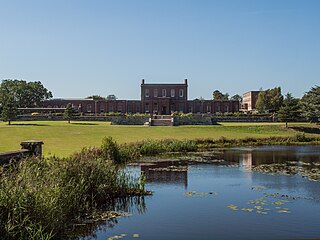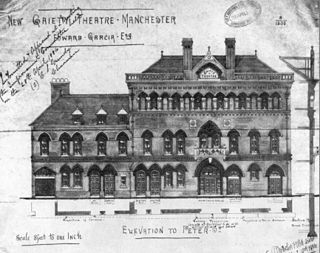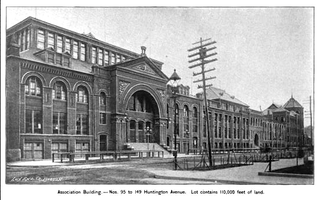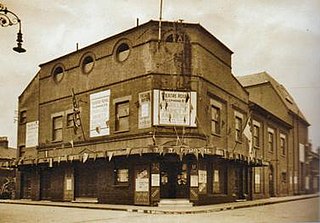 W
WThe American Church of St. John was a church building constructed in Dresden for the expatriate American community in 1883 to 1884. It was damaged by bombing in 1945 and demolished in 1959.
 W
WAshburnham Place is an English country house, now used as a Christian conference and prayer centre, five miles west of Battle, Sussex. It was one of the finest houses in the southeast of England in its heyday, but much of the structure was demolished in 1959, and only a drastically reduced part of the building now remains standing.
 W
WThe Bishop's House in Birmingham, England was designed by Augustus Pugin as the residence of Thomas Walsh, the first Roman Catholic Bishop of Birmingham. It was situated opposite St Chad's Cathedral, on the corner of Bath Street and Weaman Street in Birmingham City Centre.
 W
WThe Chiswick Empire was a theatre facing Turnham Green in Chiswick that opened in 1912 and closed and was demolished in 1959. A venue for touring artists, some of the greatest names in drama, variety and music hall performed there including George Formby, Laurel and Hardy, Chico Marx, Peter Sellers and Liberace.
 W
WThe Columbia Theatre, located at 1112 F Street NW, Washington, DC 20004, was a theater built and opened in 1891, closed and demolished in 1959. The Arnold & Porter Building is on the site today.
 W
WEl Mirasol was a 37-room Spanish Colonial Revival mansion at 348 N. Ocean Boulevard in Palm Beach, Florida. Designed by architect Addison Mizner for financier Edward T. Stotesbury, it was completed in 1920.
 W
WThe synagogue on Fraenkelufer in Berlin's Kreuzberg district was built as an Orthodox Synagogue between 1913 and 1916 according to plans and under the direction of the master builder of the Jewish Community of Berlin, Alexander Beer. The structure was located on Kottbusser Ufer 48–50, today's Fraenkelufer 10-16. On Kristallnacht, the evening of November 9-10th, 1938, the main building of the synagogue was badly damaged. Further destruction in the following years led to the structures ultimate demolition in 1958/1959 after the end of World War II. Today the surviving outbuilding, previously used for the youth service, has been renovated and is home to a Conservative Synagogue. A complete reconstruction of the main synagogue that was destroyed by the National Socialists is being planned for its original location.
 W
WThe Gaiety Theatre, Manchester was a theatre in Manchester, England. It opened in 1884 and was demolished in 1959. It replaced a previous Gaiety Theatre on the site that had been destroyed by fire.
 W
WHarlem Opera House was a US opera house located at 211 West 125th Street, in the Harlem neighborhood of Manhattan in New York City. Designed by architect John B. McElfatrick, it was built in 1889 by Oscar Hammerstein; it was his first theater in the city.
 W
WThe Massachusetts Charitable Mechanic Association (est.1795) of Boston, Massachusetts, was "formed for the sole purposes of promoting the mechanic arts and extending the practice of benevolence." Founders included Paul Revere, Jonathan Hunnewell, and Benjamin Russell. Through much of the 19th century, the association organized conferences and exhibitions devoted to innovation in the mechanical arts.
 W
WMechanics Hall was a building and community institution on Huntington Avenue at West Newton Street, from 1881 to 1959. Commissioned by the Massachusetts Charitable Mechanic Association, it was built by the noted architect William Gibbons Preston. The building was located between the Boston and Albany railroad yards and Huntington avenue. It was razed for the Prudential Center urban renewal project of the early 1960s. The site is on the north side of Huntington Avenue, and since 1941 has been served by Prudential Station of the MBTA Green Line E branch.
 W
WMonbijou Palace was a Rococo palace in central Berlin located in the present-day Monbijou Park on the north bank of the Spree river across from today's Bode Museum and within sight of the Hohenzollern city palace. Heavily damaged in World War II, the ruins were finally razed by the communist authorities of East Berlin in 1959. The palace has not been rebuilt.
 W
WThe Montgomery Block built in 1853 was San Francisco's first fireproof and earthquake resistant building. It came to be known as a Bohemian center from the late 19th to the middle of the 20th century. It was located at 628 Montgomery Street, on the southeast corner of its intersection with Washington Street, today the location of the Transamerica Pyramid.
 W
WThe Armory and Gymnasium was a campus building of the Ohio State University in Columbus, Ohio. The building was designed by prominent Ohio architects Yost & Packard and built in 1898. The multipurpose facility had a gymnasium, canvas running track, seats for 750, two swimming pools, and a cannon room. The building was home to Ohio State's men's basketball team. In 1918, the U.S. Army took over the building and used it for troop housing during World War I. The building stood through a fire in 1935. Another fire devastated the building in 1958, damaging it beyond repair. The building was demolished in 1959. The Wexner Center for the Arts opened on the site in 1989, with architecture inspired by the 1898 building.
 W
WOssian Hall was an 18th-century plantation house in Annandale, Fairfax County, Virginia. Ossian Hall was one of three large residences, along with Oak Hill, and Ravensworth, owned by the Fitzhugh family in Fairfax County.
 W
WThe Phoenix Hotel was a hotel located in Turku, Finland, on the edge of the Market Square along the street Kirkkokatu, which operated from 1878 to 1922. The building was known as the Phoenix House even when it was the main building of the private University of Turku, founded in 1920. The Phoenix House was demolished in 1959.
 W
WThe Provident Life & Trust Company in Philadelphia, Pennsylvania, a demolished Victorian-era building by architect Frank Furness, is considered to have been one of his greatest works. A bank and insurance company founded in 1865 by members of the Society of Friends (Quakers), the Provident's L-shaped building had entrances at 407-09 Chestnut Street (bank) and 42 South 4th Street. The two wings were eventually consolidated into an office building at the northwest corner of 4th & Chestnut Streets.
 W
WThe Seven Buildings were seven townhouses constructed on the northwest corner of Pennsylvania Avenue NW and 19th Street NW in Washington, D.C., in 1796. They were some of the earliest residential structures built in the city. One of the Seven Buildings was the presidential home of President James Madison and his wife, Dolley, after the burning of the White House in 1814, and later the residence of Martin Van Buren shortly before and after his inauguration as President. Most of the buildings were demolished in 1959. The facades of two buildings were incorporated into the Embassy of Mexico in 1986.
 W
WThe Theatre Royal was a theatre in Aldershot in Hampshire which opened in 1891 and was demolished in 1959. The teenage Charlie Chaplin appeared there in 1904 and the actor James Mason is believed to have made his stage début at the theatre in 1931.
 W
WThe Wisconsin Chair Company was a manufacturer of furniture and crafted wood products from the late 19th to the mid-20th century. It ran a large factory that for over half a century was the economic backbone of Port Washington, Wisconsin. The factory was destroyed twice: the first time by a huge, devastating fire in 1899 and the second time by demolition in 1959.